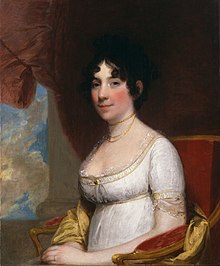Dolley Madison | |
|---|---|
 1804 portrait by Gilbert Stuart | |
| First Lady of the United States | |
| In role March 4, 1809 – March 4, 1817 | |
| President | James Madison |
| Preceded by | Martha Randolph (acting) |
| Succeeded by | Elizabeth Monroe |
| Personal details | |
| Born | Dolley Payne May 20, 1768 Guilford County, North Carolina, British America |
| Died | July 12, 1849 (aged 81) Washington, D.C., U.S. |
| Resting place | Montpelier, Virginia, U.S. 38°13′07.5″N 78°10′06.0″W / 38.218750°N 78.168333°W |
| Spouses | |
| Children |
|
| Signature | |
Dolley Todd Madison (née Payne; May 20, 1768 – July 12, 1849) was the wife of James Madison, the fourth president of the United States from 1809 to 1817. She was noted for holding Washington social functions in which she invited members of both political parties, essentially spearheading the concept of bipartisan cooperation. Previously, founders such as Thomas Jefferson would only meet with members of one party at a time, and politics could often be a violent affair resulting in physical altercations and even duels. Madison helped to create the idea that members of each party could amicably socialize, network, and negotiate with each other without violence.[1] By innovating political institutions as the wife of James Madison, Dolley Madison did much to define the role of the President's spouse, known only much later by the title First Lady—a function she had sometimes performed earlier for the widowed Thomas Jefferson.[2]
Madison also helped to furnish the newly constructed White House. When the British set fire to it in 1814, she was credited with saving Gilbert Stuart's classic 1796 portrait of George Washington; she directed her personal slave Paul Jennings to save it.[3] In widowhood, she often lived in poverty aggravated by her son John Payne Todd's alcoholism and mismanagement of their Montpelier plantation. To relieve her debts, she sold off the plantation, its remaining enslaved people, and her late husband's papers.
Surveys of historians conducted periodically by the Siena College Research Institute since 1982 have consistently found Madison to rank among the six most highly regarded first ladies by the assessments of historians.
- ^ "Unofficial Politician: Dolley Madison in Washington". New York Historical Society. Archived from the original on July 31, 2018. Retrieved July 31, 2018.
- ^ Allgor, Catherine (2006). A Perfect Union: Dolley Madison and the Creation of the American Nation. New York: Henry Holt & Co. p. 43. ISBN 0-8050-7327-2.
- ^ "Summer 1814: Dolley Madison saves Washington's portrait, with some help (U.S. National Park Service)". www.nps.gov. Archived from the original on December 5, 2019. Retrieved June 14, 2019.